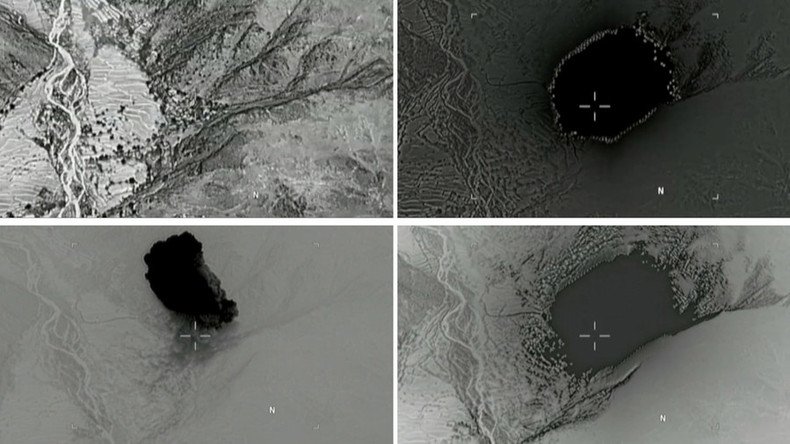Devastating capabilities of mega-bomb raise questions over official death toll

Doubts have been cast over reports that the MOAB dropped by US forces in Afghanistan killed 36 Islamic State fighters, in light of its strength and the speed at which the death toll was reported.
The Massive Ordnance Air Blast (MOAB) was dropped on a tunnel complex in the Achin district in Nangarhar province near the Pakistan border, said to be used by affiliates of Islamic State (IS, formerly ISIS/ISIL) on Thursday.
While Afghan officials were quick to announce there were no civilian casualties as a result of the bomb, and US Central Command said forces “took every precaution to avoid civilian casualties with this strike.” Yet the weapon’s documented force and the remote location of the blast has caused some to question how quickly, and with what degree of accuracy, death could be tallied.
Video footage released by the US shows the devastation of the blast, which appeared to leave a large crater.
@AP How did they count 36 bodies in 24 hours if all the tunnels collapsed under the earth?
— VegasBuckeye75 (@LasVegasBuckeye) April 14, 2017
@AP A #MOAB Bomb weighs more than 10,000 kilograms and contains 8,164 kilograms of explosives. Yet they counted 36 #ISIS rebels?
— 🕊️ (@Nexxus7) April 14, 2017
Total Bullshit!
US on MOAB: "There is no evidence of civilian casualties"
— jon campbell (@jon__campbell) April 14, 2017
Of course not, it completely obliterates everything within a mile radius.
@MailOnline How do they know it was 36? Bodies will be difficult to identify after such a big blast & ppl trapped in collapsed tunnels hard to locate.
— Tony Hui (@TonyHui99) April 14, 2017
Sher Nabi, a commander with the Afghan Local Police, told the LA Times that the bomb landed about a half mile outside the town of Shogal, near the border with Pakistan and that "many militants" were killed.
Inamullah Meyakhil, a spokesperson for the central hospital in eastern Nangarhar, said they had received no dead or wounded from the attack.
“The explosion was the biggest I have ever seen,” Achin District Governor Esmail Shinwari told AFP. “Towering flames engulfed the area.”
Shinwari later said locals told him a teacher and son were killed, the Guardian reports, while the New York Times reports four houses in the Pekhe area, about three miles from the blast, were completely destroyed.
Israr Shinwari tells me, he lives 2km far from the area & the blast caused by #MOAB cracked his room's wall & shattered window glasses.
— Habib Khan Totakhil (@HabibKhanT) April 14, 2017
CIVILIAN CASUALTY CONCERNS
The MOAB was developed during the Iraq war and was never used after testing, due to concerns of mass civilian casualties.
Marc Garlasco, a former Pentagon official in charge of high-value targets, told the Intercept that the Pentagon considered using the bomb in 2003, but decided against it because “the civilian harm greatly outweighed the military gain.”
Defense Secretary Donald Rumsfeld said at the time that “the goal is to have the capabilities of the coalition so clear and so obvious that there is an enormous disincentive for the Iraqi military to fight against the coalition.”
US never dropped the MOAB in Iraq due to collateral damage concerns. I was on the targeting team that considered it @barbarastarrcnnhttps://t.co/ypq6uyVSbg
— marcgarlasco (@marcgarlasco) April 13, 2017
Garlasco described the MOAB’s blast radius as “beyond huge” and told the Intercept he was sure the “collateral damage estimate is going to be fairly extensive.”
READ MORE: Meet the ‘Mother Of All Bombs’: 6 facts about bomb Trump dropped on Afghanistan
Former Afghan President Hamid Karzai has “vehemently” condemned the bombing in a series of tweets. Describing it as “brutal misuse of our country,” he accused the US of using Afghanistan as a “testing ground for new and dangerous weapons.”
I vehemently and in strongest words condemn the dropping of the latest weapon, the largest non-nuclear #bomb, on Afghanistan by US...1/2
— Hamid Karzai (@KarzaiH) April 13, 2017
2/2 military. This is not the war on terror but the inhuman and most brutal misuse of our country as testing ground for new and dangerous...
— Hamid Karzai (@KarzaiH) April 13, 2017
2/3 weapons. It is upon us,Afghans, to stop the #USA.
— Hamid Karzai (@KarzaiH) April 13, 2017
Wouldn't it make more sense to drop 100,000 inventory-sitting new cars on Afghanis and count those as 'sales' to boost U.S. GDP?
— Max Keiser (@maxkeiser) April 14, 2017












